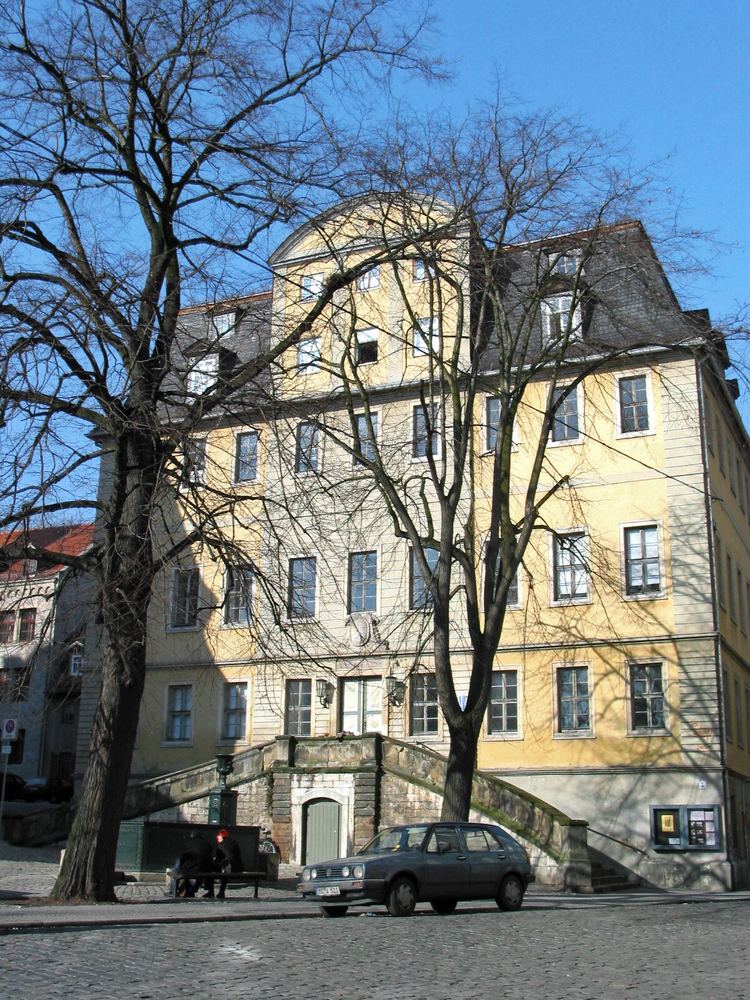 | ||
The Wilhelm-Ernst-Gymnasium is a secondary school on Herderplatz 14 in Weimar, Germany. Founded in 1712 by Duke William Ernest of Saxe-Weimar, it is the oldest school building in the city. Numerous notable figures such as Johann Gottfried Herder, Johann Heinrich Voss, Friedrich Wilhelm Riemer and Johann Karl August Musäus studied here. It is a designated historic site and is one of the few secular buildings of the pre-classical period still remaining in Weimar. It is prominently located in the urban center and is one of three sites forming the UNESCO World Heritage Site Classical Weimar, created in 1998.
Contents
History
The Wilhelm-Ernst-Gymnasium was founded in 1712 at the behest of William Ernest, Duke of Saxe-Weimar, to replace the Stadt- und Landschule (school of the town and the region) of 1561. Among the teachers were Johann Heinrich Voss, Friedrich Wilhelm Riemer and Johann Karl August Musäus. In 1776 Weimar General Superintendent Johann Gottfried Herder took over as the director and headmaster, and was also superintendent of all the schools of the Duchy of Saxe-Weimar-Eisenach. From 1784, Karl August, Grand Duke of Saxe-Weimar-Eisenach, of Saxe-Weimar-Eisenach permitted the Reformed congregation to use the hall for church services. By 1800 the school installed a library. In the 19th century the building served as a humanistisches Gymnasium. Growing numbers of students led to a move to a larger school building on 10 October 1887, called Goethe Gymnasium Weimar since 1991. The old building served from 1910 as the Großherzoglich-Sächsische Baugewerkenschule Weimar. From 1953, the building housed a Museum of Natural History and a Polytechnisches Zentrum, classrooms and production areas for technical teaching.
Building
The school building, in the Baroque style, was built from 1712 to 1716 next to the church St. Peter und Paul on the Herderplatz and inaugurated by state architect Christian II Richter. It bears the inscription "Soli Deo Gloria" (Glory to God alone). It is a three-storey building with a high mansard roof. The facade is highlighted by a three-axis avant-corps, crowned by a spire light. A sweeping, double flight staircase dominates the square. In 1976, the once spacious foyer, which linked the ground floor to the top floor, was closed in favor of an additional classroom, and a massive staircase was built as a steel structure with concrete steps. On the ground floor and the first floor, the building has six large classrooms and a hall with a preserved stucco ceiling. The upper floors held previously apartments for the teachers.
Later usage
The premises of were used after 1990 by a non-commercial local broadcaster, Radio Lotte, to 2008, and by the Volkshochschule Weimar. The Classical Weimar, an ensemble of the former high school, the Herder House and the church St. Peter und Paul, is currently restored for € 5,4 million from the Investitionsprogramm Nationale UNESCO Welterbestätten (National Investment Program UNESCO World Heritage Sites) of the Federal Government. No agreement for a future use was reached. One idea is to set up a Herder museum", to commemorate the work of the poet, translator, philosopher and theologian at the site of his former workplace.
Directors
Senior Deputy Vice Presidents and Directors of the high school (in order of tenure):
Professors
Known teachers and professors of the high school (in order of teaching time):
Alumni
Notable students and graduates of the high school (in order of birth):
